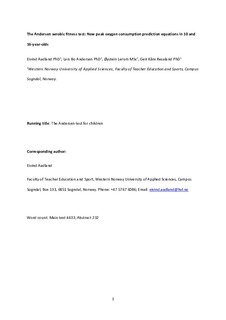| dc.contributor.author | Aadland, Eivind | |
| dc.contributor.author | Andersen, Lars Bo | |
| dc.contributor.author | Lerum, Øystein | |
| dc.contributor.author | Resaland, Geir Kåre | |
| dc.coverage.spatial | Norway, Sogn og Fjordane | nb_NO |
| dc.date.accessioned | 2019-03-01T13:50:40Z | |
| dc.date.available | 2019-03-01T13:50:40Z | |
| dc.date.created | 2018-01-23T21:05:35Z | |
| dc.date.issued | 2018 | |
| dc.identifier.citation | Aadland, E., Andersen, L. B., Lerum, Ø., & Resaland, G. K. (2018). The Andersen aerobic fitness test: New peak oxygen consumption prediction equations in 10 and 16-year olds. Scandinavian Journal of Medicine & Science in Sports, 28, 862-872. | nb_NO |
| dc.identifier.issn | 0905-7188 | |
| dc.identifier.uri | http://hdl.handle.net/11250/2588320 | |
| dc.description | This is the peer reviewed version of the following article: Aadland, E., Andersen, L. B., Lerum, Ø., & Resaland, G. K. (2018). The Andersen aerobic fitness test: New peak oxygen consumption prediction equations in 10 and 16-year olds. Scandinavian Journal of Medicine & Science in Sports, 28, 862-872, which has been published in final form at https://onlinelibrary.wiley.com/doi/full/10.1111/sms.12985. This article may be used for non-commercial purposes in accordance with Wiley Terms and Conditions for Use of Self-Archived Versions. | nb_NO |
| dc.description.abstract | Measurement of aerobic fitness by determining peak oxygen consumption (VO2peak) is often not feasible in children and adolescents, thus field tests such as the Andersen test are required in many settings, for example in most school‐based studies. This study provides cross‐validated prediction equations for VO2peak based on the Andersen test in 10 and 16‐year‐old children. We included 235 children (n = 113 10‐year olds and 122 16‐year olds) who performed the Andersen test and a progressive treadmill test to exhaustion to determine VO2peak. Joint and sex‐specific prediction equations were derived and tested in 20 random samples. Performance in terms of systematic (bias) and random error (limits of agreement) was evaluated by means of Bland‐Altman plots. Bias varied from −4.28 to 5.25 mL/kg/min across testing datasets, sex, and the 2 age groups. Sex‐specific equations (mean bias −0.42 to 0.16 mL/kg/min) performed somewhat better than joint equations (−1.07 to 0.84 mL/kg/min). Limits of agreement were substantial across all datasets, sex, and both age groups, but were slightly lower in 16‐year olds (5.84‐13.29 mL/kg/min) compared to 10‐year olds (9.60‐15.15 mL/kg/min). We suggest the presented equations can be used to predict VO2peak from the Andersen test performance in children and adolescents on a group level. Although the Andersen test appears to be a good measure of aerobic fitness, researchers should interpret cross‐sectional individual‐level predictions of VO2peak with caution due to large random measurement errors. | nb_NO |
| dc.language.iso | eng | nb_NO |
| dc.publisher | Wiley | nb_NO |
| dc.subject | cardiorespiratory fitness | nb_NO |
| dc.subject | measurement | nb_NO |
| dc.subject | agreement | nb_NO |
| dc.subject | prediction | nb_NO |
| dc.subject | field test | nb_NO |
| dc.title | The Andersen aerobic fitness test: New peak oxygen consumption prediction equations in 10 and 16-year olds | nb_NO |
| dc.type | Journal article | nb_NO |
| dc.type | Peer reviewed | nb_NO |
| dc.description.version | acceptedVersion | nb_NO |
| dc.subject.nsi | VDP::Medisinske Fag: 700::Idrettsmedisinske fag: 850 | nb_NO |
| dc.source.pagenumber | 862-872 | nb_NO |
| dc.source.volume | 28 | nb_NO |
| dc.source.journal | Scandinavian Journal of Medicine & Science in Sports | nb_NO |
| dc.source.issue | 3 | nb_NO |
| dc.identifier.doi | 10.1111/sms.12985 | |
| dc.identifier.cristin | 1550404 | |
| cristin.unitcode | 203,10,1,0 | |
| cristin.unitcode | 203,10,13,0 | |
| cristin.unitname | Institutt for idrett, kosthald og naturfag | |
| cristin.unitname | Nasjonalt senter for mat, helse og fysisk aktivitet | |
| cristin.ispublished | true | |
| cristin.fulltext | postprint | |
| cristin.qualitycode | 2 | |
